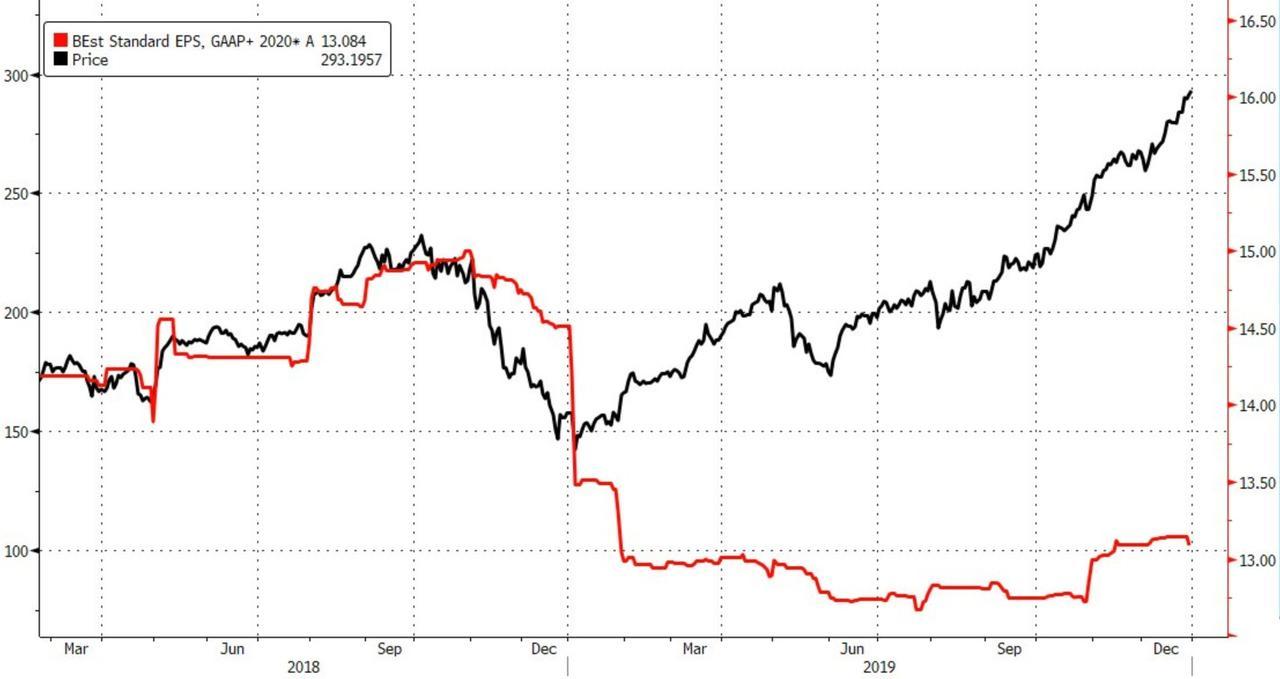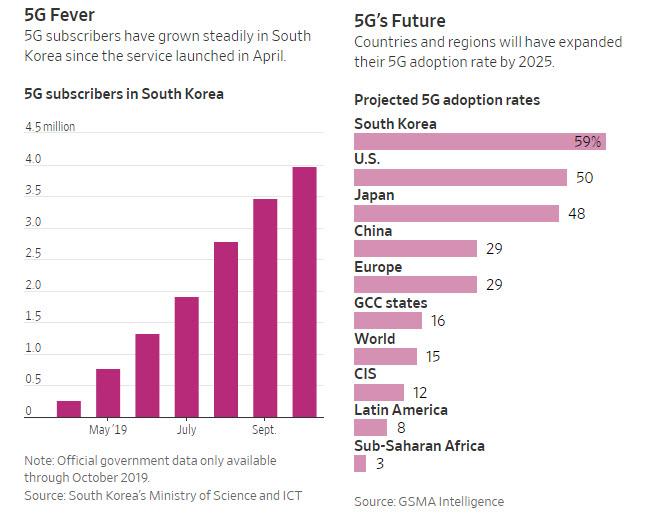“I’m Not Recommending Anyone Use It”: First 5G Rollout Fails To Live Up To The Hype
When Apple stock closed last year at an all time high after doubling from its January 2019 lows, there were many confused looks among the trader community: after all any attempts to justify the move through the company’s future earnings – which haven’t budged in the past year – would only provoke laughter.
Instead, there were two other explanations being suggested: the company’s record stock buybacks, which helped to drastically expand AAPL’s PE multiple, and the looming “paradigm shift” that is 5G and Apple’s launch of 5G-compatible phones.
Well, for those who bet the farm on the latter, there may be a slight problem, because while 5G has yet to be made available in most countries, one nation has already had a 5G offering for 8 months: South Korea, and early adopters here have been anything but excited about the “5G revolution.”
when 5G services were launched there in April, Jang Dong-gil was among the first wave of South Koreans to sign up. Now eight months in, Jang, a 30-year-old tech company worker, has a chilling review for the next-generation technology: 5G hasn’t lived up to the hype.
“I don’t feel the difference,” Jang, who has been using a 5G-enabled Samsung handset, told the WSJ. In fact, on many days he switches off his 5G service altogether because his connection often drops as his phone pingpongs between 5G and the existing 4G LTE network.
With the rest of the world eagerly awaiting its own 5G rollout, all eyes were on South Korea, which for most of 2019 was home to the vast majority of the world’s 5G users, offering the broadest lessons in what the next-generation network has to offer. Yet where any hope that Apple’s will merely jump to a $2 billion (or higher) valuation could crash and burn is that although it is still early in the global rollout, 5G service in South Korea has proved more of a future promise than a technological breakthrough.
Of course, it’s not just phones: 5G launched during the past year promising to help power a future of autonomous “everything”: from cars, to virtual reality and telesurgery, thanks to its theoretical speeds of up to 100 times faster than today’s 4G networks. In fact, the next-generation network’s potential has been at the forefront of the technological war between the US and China, setting off a technological arms race – and associated trade war – between Beijing and Washington, which has pressured allies to avoid adopting equipment made by China’s Huawei over national-security and other concerns.
For better or worse, it is now seen – if only symbolically – that the company, and the nation, behind the infrastructure that allows global adoption of 5G will be the world’s next technological superpower. As such, many countries are scrambling to deploy the superfast network, hoping homegrown companies can enjoy an early advantage providing new, popular services like those from Uber, Instagram and Netflix that flourished during the 4G era. Currently, few, if any, 5G apps have emerged that would justify an upgrade by consumers.
And while 5G is now operational in Korea (we hope we don’t have to clarify that we are talking about the South version), larger countries are now also beginning the transition. In the U.S., 5G services have been rolled out in select cities—though adoption remains modest, requiring consumers to buy a new phone and, in some cases, subscribe to a top-tier, unlimited data plan.
In China, the rollout is far more aggressive: the government has prioritized expanding access to 5G since its launch in November, and by the end of 2020, China’s 5G subscribers are estimated to hit 120 million, said Chris Lane, an analyst at Bernstein Research. But initial 5G showcases have been limited to tests such as remote telesurgery procedures or streaming a dance performance in a remote village.
Predictably, South Korea is much further along and is expected to end 2019 with more than 4.5 million subscribers among its population of 51 million, according to telecom analysts polled by the WSJ.
In April, the country’s top three carriers – KT Corp, SK Telecom and LG Uplus – launched 5G service on the same day Verizon Communications debuted in two U.S. cities. From the very start, about half of South Korea’s population could have access to 5G service after buying a network-enabled device.
On their 5G phones, South Korean users – who have traditionally had access to all the latest and greatest cell phone technology first – can live-stream sports with a 360-degree view of the action, watching from any angle and in slow motion. Visitors to a Seoul park can summon a giant cat on their phone’s screen as they take in the scenery using augmented reality. Another app lets people gather in virtual-reality rooms to watch baseball games or concerts together.
However, such 5G “flourishes” are still merely attention-grabbing gimmicks which have yet to draw a large audience: “There’s no killer 5G app,” said Woody Oh, a Seoul-based analyst at Strategy Analytics.
“As far as adoption goes, we’re still at the very start,” said Julian Gorman, head of Asia-Pacific for GSMA, a trade association for mobile carriers. We’re eight months into a cycle that’s going to be many years in length,” he said.
Or perhaps 5G is merely an extremely conveient service in search of a spark, and only Apple can provide it. After all, 3G networks, which enabled data transfers among device users and launched in 2001, didn’t fully kick off until Apple’s first iPhone came out in 2007. It took years for its successor, 4G, to bring in ride-sharing platforms like Uber and Grab Holdings since it launched in 2011.
Where does 5G come in? For now, 5G’s main visible benefit lies in transferring large amounts of data extremely quickly, such as downloading movies faster and streaming high-resolution content seamlessly. That could be handy – after all, some 70% of data traffic carried from mobile devices to an operator comes from video content, compared with less than 25% five years ago. That figure is expected to rise further with 5G.
Yet is it truly revolutionary that one will be able to download a pirated version of the latest Star Wars movie on their cell phone in seconds instead of minutes? Indeed, telecom experts say 5G’s advantages are hard for consumers to experience with smartphones. Instead, the bigger leap will be felt with self-driving cars or smart cities, they say.
For current users, though, a key challenge is simply staying connected to 5G.
Take Yun Seung-yeol, a 27-year-old architectural designer in South Korea, who was given a big enticement to sign up for the new service: he got subsidies from his telecom provider to shave about two-thirds off the roughly $1,000 price tag for a 5G-enabled Galaxy Note 10 device.
He said he notices a difference on the superfast network only when downloading files or images on his phone. Besides that it’s a nuisance. Yun, who has an hour-long commute to his Seoul office, said he has turned off the 5G feature on his device for the past month because he kept losing connection when he left Seoul for his home in a neighboring city. He is considering switching back to a 4G data plan if the situation doesn’t improve.
“For now, I’m not recommending anyone to use 5G,” Yun said, uttering the scariest words for anyone who bought AAPL stock near its all time highs on expectations that the stock will continue to soar in 2020 just because of the relentless 5G hype…
Tyler Durden
Wed, 01/01/2020 – 23:30
via ZeroHedge News https://ift.tt/2ZIVGtn Tyler Durden

